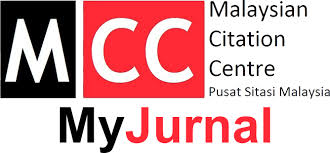AMALAN HUMOR GURU DAN HUBUNGANNYA DENGAN KONSENTRASI DAN INGATAN BELAJAR MURID DALAM PEMBELAJARAN BAHASA MELAYU [TEACHER'S HUMOR PRACTICE AND ITS RELATIONSHIP WITH STUDENTS' LEARNING CONCENTRATION AND MEMORY IN MALAY LEARNING]
Keywords:
Humor, Bahasa Melayu, Sekolah Rendah Humour, Malay language, Elementary schoolAbstract
Abstrak: maklumat yang diajarkan oleh guru di dalam kelas. Oleh itu, kajian ini dijalankan untuk mengenal pasti tahap persepsi, tahap konsentrasi dan tahap ingatan murid terhadap amalan humor guru dalam pembelajaran Bahasa Melayu serta melihat korelasi antara amalan humor guru dengan konsentrasi dan ingatan belajar murid. Reka bentuk kajian ini ialah kuantitatif dengan menggunakan kaedah tinjauan. Seramai 250 orang murid sekolah rendah tahap 2 iaitu tahun 4, 5 & 6 di daerah Membakut telah dipilih sebagai responden kajian melalui persampelan rawak. Instrumen kajian terdiri daripada satu set soal selidik yang diadaptasi dan mempunyai empat bahagian. Dapatan kajian menunjukkan bahawa tahap persepsi (M= 3.77, SP=.49) dan tahap konsentrasi (M= 3.14, SP=.37) murid terhadap amalan humor guru, kedua-duanya berada pada tahap sederhana tinggi. Manakala, bagi tahap ingatan belajar murid pula berada pada tahap sederhana rendah (M= 2.83, SP=.43). Hasil analisis korelasi Pearson juga mendapati bahawa terdapat hubungan signifikan antara amalan humor guru dengan konsentrasi (r=.580, p=<.001) dan ingatan (r=.984, p=<.001) dalam pembelajaran Bahasa Melayu. Kesimpulannya, tahap persepsi dan konsentrasi murid adalah positif dan memuaskan. Namun, tahap ingatan murid masih berada pada tahap yang kurang memuaskan. Oleh itu, para guru perlu meneliti semula pelaksanaan humor dalam pembelajaran Bahasa Melayu kerana semakin tinggi amalan humor guru maka semakin tinggi tahap konsentrasi dan ingatan belajar murid. Justeru, para pendidik perlu mengaplikasikan dan menerapkan humor dalam pengajaran dan pembelajaran Bahasa Melayu dengan kreatif dan bermakna.
Abstract: Humour is an essential element to capture the interest of students in receiving information taught by teachers in the classroom. Therefore, this study was conducted to identify the level of perception, concentration, and memory of students towards the practice of teacher humour in learning the Malay language as well as to analyze the correlation between teacher humour practices and student learning concentration and memory. The study design is quantitative using a survey method. A total of 250 primary school students in years 4, 5, and 6 in the Membakut district were selected as respondents for the study through random sampling. The research instrument consists of a set adapted questionnaires with four sections. Study results showed that students’ level of perception (M=3.77, SP=49) and level of concentration (M =3.14, SP=.37) of the teacher’s humour practice were both on a moderate high level. Meanwhile, for the level of learning memory students are at a medium low level (M=2.83, SP=.43). Pearson’s correlation analysis also found that there was a significant relationship between teacher humour practices with concentration (r=580, p=<.001) and memory (r =.984, p = <.001) in Malay language learning. In conclusion, the level of perception and concentration of students is positive and satisfying. However, the level of student memory is still at a less satisfactory level. Therefore, teachers need to review the implementation of humor in Malay language learning because the higher the practice of teacher joke, the higher is the level of concentration and student learning memory. Therefore, educators need to apply humor in teaching and learning Malay language creatively and meaningfully.












